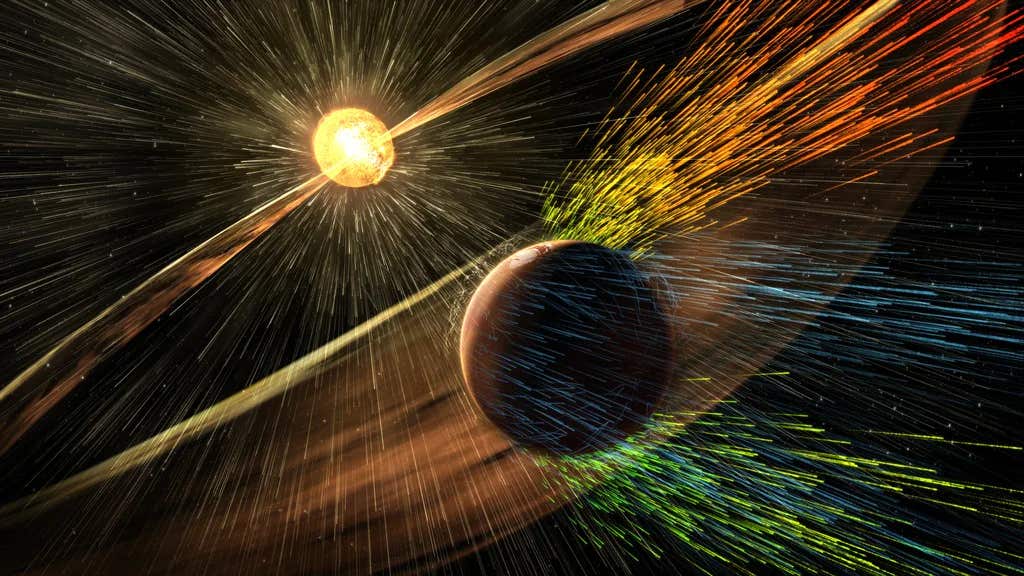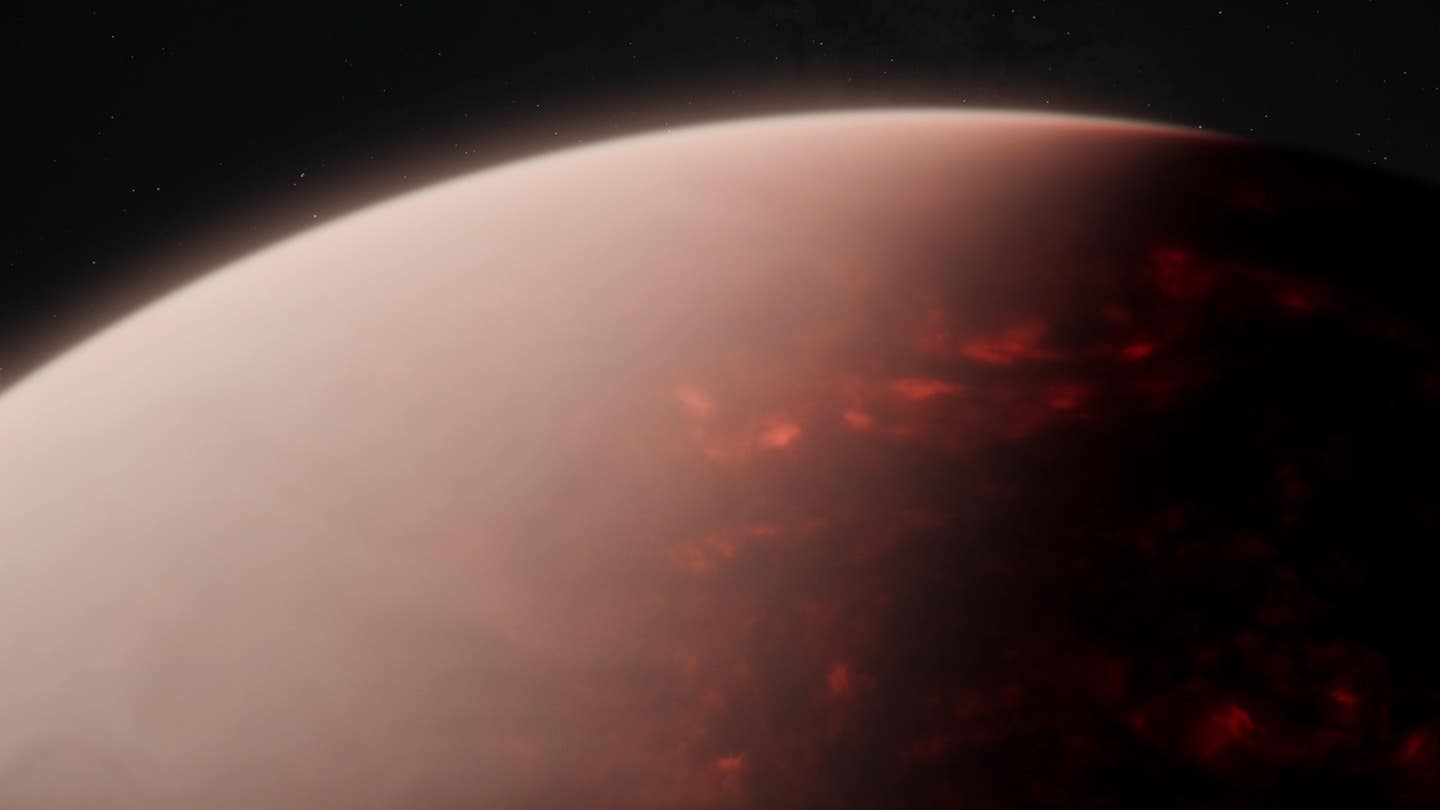First direct evidence of how Mars lost its thick atmosphere and water
For years, scientists have puzzled over how Mars lost the thick atmosphere it once had. That atmosphere was essential for liquid water to exist on the planet’s surface, billions of…

Scientists directly observe sputtering on Mars, revealing how its ancient atmosphere and liquid water were lost to space. (CREDIT: NASA)
For years, scientists have puzzled over how Mars lost the thick atmosphere it once had. That atmosphere was essential for liquid water to exist on the planet’s surface, billions of years ago. Today, new data from NASA’s Mars Atmosphere and Volatile Evolution mission—MAVEN—finally brings answers.
After nearly a decade in orbit, MAVEN has delivered the first direct observations of a powerful and long-suspected process known as sputtering. This breakthrough offers a clearer picture of what stripped Mars’ atmosphere and dried up its ancient water.
A Missing Shield and a Vanishing Atmosphere
Unlike Earth, Mars doesn’t have a global magnetic field to protect it from space weather. That left its upper atmosphere open to the solar wind—charged particles that stream out from the Sun. These particles carry electric fields and slam into Mars with enough force to cause big changes.
One of the most important changes is atmospheric escape. When the Sun’s energy hits Mars’ upper atmosphere, it can knock particles loose and push them into space. Some of this happens slowly through well-known processes like photochemistry. But sometimes, it happens violently.
That’s where sputtering comes in. This process starts when heavy ions are blasted toward the planet by solar wind electric fields. When they crash into Mars’ upper atmosphere, they transfer energy to neutral atoms, such as argon. Some of these energized atoms get kicked so hard that they fly off the planet and never return.
“It’s like doing a cannonball in a pool,” said Shannon Curry, MAVEN’s principal investigator at the University of Colorado Boulder. “The cannonball, in this case, is the heavy ions crashing into the atmosphere really fast and splashing neutral atoms and molecules out.”
For a long time, scientists had suspected that sputtering played a major role in Mars’ early atmospheric loss, but no one had ever seen it happen directly—until now.
Related Stories
Argon: The Perfect Clue
Measuring sputtering is hard. It happens high above the surface, where only a few spacecraft can make the right observations. Plus, most of the gases in Mars’ atmosphere are reactive, like oxygen and carbon dioxide. These gases undergo complex chemical changes that make it tough to tell whether they’ve been lost through sputtering or other processes.
Argon is different. It’s a noble gas—heavy, stable, and chemically inert. That means argon doesn’t react much with anything and doesn’t get caught up in other escape processes. It also has two isotopes, 36Ar and 38Ar. Over time, sputtering would be expected to remove the lighter isotope, 36Ar, more easily. When scientists studied the ratio of these isotopes in the atmosphere, they found far less of the lighter one than expected—an early clue that sputtering had shaped Mars' past.
“It is like we found the ashes from a campfire,” Curry said. “But we wanted to see the actual fire, in this case sputtering, directly.”
The First Clear Sight of Sputtering
To catch sputtering in action, researchers needed a rare combination: the right instruments, the right orbit, and the right solar conditions. MAVEN had all three.
Three instruments aboard MAVEN played key roles. The Solar Wind Ion Analyzer tracked charged particles from the Sun. The Magnetometer measured the magnetic field. The Neutral Gas and Ion Mass Spectrometer detected argon at different heights in the atmosphere.
MAVEN’s orbit also helped. To measure sputtering, the spacecraft had to observe both the incoming ions and the escaping argon. It also needed to collect data across all times of day—both the sunlit side and the dark side of Mars. That took years of patient orbiting and careful data gathering.
With this data, scientists made a new type of map. It showed where solar wind electric fields pointed into the planet, a configuration known as the “−E hemisphere.” In those zones, heavy ions are driven downward and are likely to trigger sputtering. At the same time, the data revealed high concentrations of argon at altitudes above 360 kilometers—exactly where models predicted sputtering would dominate.
Even more surprising, the rate of argon escape was over four times higher than expected. During a solar storm, that rate jumped even further. This gave researchers a glimpse into what the Martian atmosphere might have faced billions of years ago, when solar storms were more intense and common.
Modeling the Martian Past
To confirm what they were seeing, scientists ran advanced simulations. These included a hybrid plasma model called LatHyS and an exospheric model known as EGM. These tools allowed them to model how ions moved through Mars’ upper atmosphere, how they precipitated downward, and what neutral particles were ejected as a result.
In these simulations, the researchers separated the argon into three groups: a thermal component close to the surface, a photochemical component from dissociative recombination, and the sputtered component that comes from ion collisions. The sputtered argon was dominant only at very high altitudes and mostly on the nightside of the planet. This matched MAVEN’s real-world data perfectly.
By removing variables like local time and solar zenith angle, scientists could isolate the true sputtering signal. The match between the data and the models was the final proof.
“These results establish sputtering’s role in the loss of Mars’ atmosphere and in determining the history of water on Mars,” said Curry.
A Window Into Habitability
This discovery doesn’t just explain a long-lost atmospheric process—it also reshapes our understanding of Mars’ ability to support life. Billions of years ago, liquid water may have filled valleys, lakes, or even shallow seas on Mars. But for water to exist in that form, the planet needed a thick atmosphere to trap heat and support pressure at the surface.
Now it’s clear that sputtering helped strip that protective layer away. The loss wasn’t gentle—it was driven by intense space weather and fueled by solar storms far more powerful than those we experience on Earth.
By proving that sputtering still happens today, researchers gain insight into how fierce the process must have been in the past, when the Sun was younger and more active.
This understanding also adds a new tool in the search for habitable conditions beyond Earth. If sputtering played such a major role in changing Mars, then similar processes could be shaping other planets—or even moons—in our solar system and beyond.
The new findings, published in Science Advances, mark a major leap in planetary science. They also show the power of long-term space missions like MAVEN. After nearly ten years in orbit, the spacecraft is still rewriting what we know about Mars—and bringing us closer to understanding the deep history of our solar system.
Note: The article above provided above by The Brighter Side of News.
Like these kind of feel good stories? Get The Brighter Side of News' newsletter.



